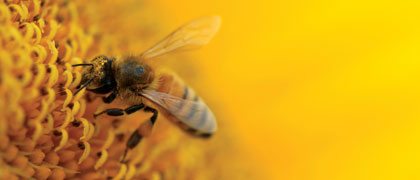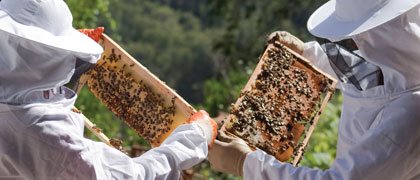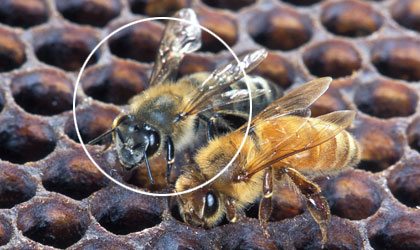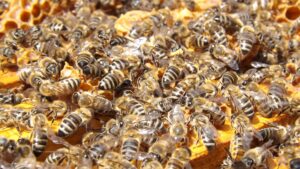Part two of Seed World’s Protecting Pollinators series delves into the combination of stressors affecting honey bee health and threatening the honey bee pollination industry, potentially placing our global food supply at risk.
A steady decline in honey bee health during the past several years has attracted the attention of agricultural and scientific communities in North America. Apis mellifera, the western honey bee, has reached a critical juncture as large, overwinter die-offs of colonies continue to plague the honey bee pollination industry.
Last October, the United States Department of Agriculture, the United States Environmental Protection Agency and Penn State University organized the National Stakeholders Conference on Honey Bee Health to gather stakeholder input and consider future actions to promote health and mitigate risks to North America’s managed honey bees.
|
QUICK FACT |
“Currently, the survivorship is too low for us to be confident in our ability to meet the pollination demands of U.S. agricultural crops,” said Jeff Pettis, USDA Agriculture Research Service’s bee research leader, during a presentation at the conference called The Current State of Knowledge of CCD and its Relation to Honey Bee Health.
“Honey bee colonies have been dying at a rate of about 30 percent per year over the past few winters, which leaves virtually no cushion of bees for pollination,” he said.
Since 2006, significant progress has been made in understanding the factors associated with colony losses and the overall health of honey bees, including the sequencing of the honey bee genome. However, many experts agree that the problem has proven to be complex and difficult to solve.
“No single silver bullet will solve the problems affecting honey bees and other pollinators,” explained Pettis. “It is imperative that we increase honey bee survival, both to make beekeeping profitable but more importantly to meet the demands of U.S. agriculture for pollination, and thus ensure food security.”
Upon conclusion of the conference, the USDA listed nutritional deficiencies, pests and pathogens, and pesticide exposure as the major factors negatively affecting honey bee health in North America while beekeeping practices and loss of genetic diversity in bee breeding also played roles affecting honey bee health.
“Habitat enhancement, judicious and targeted pesticide use, improved colony management techniques and improved disease- and pest-resistant stocks of bees are collectively needed to improve the health of honey bee colonies,” said Pettis.
Significant progress has been made in understanding the factors associated with colony losses. However, experts agree, the problem has proven complex and difficult to solve.
Nutrition
Ensuring honey bees have appropriate nutrition and access to proper forage is a critical piece of the puzzle in keeping colonies healthy. Good nutrition helps bees maintain a healthy immune system, including detoxification systems which permit bees to fight off stressors such as pesticides and pathogens.
“Honey bees need carbohydrates and proteins to supply all of their needs for adult bee activity and brood development,” explains Dick Rogers, an apiologist with Bayer CropScience’s Bee Care Center. “This has to be a continuous supply during the brood-rearing season and over the winter they need a surplus stored that they can access.”
Honey bees will not thrive unless they have adequate supplies of approximately 10 amino acids. No single plant source provides all of them, or even more than a few. Bees will naturally seek out diverse forage, but in monocultures, and where herbicides are used heavily, that forage may be limited.
“A single forage source is not usually adequate. They need to visit different plants in order to get a blend of pollen to produce what they need,” says Rogers. “Some pollen is available in very large quantities—a good example of this is corn pollen—but even when pollen is available in large amounts, sometimes it isn’t helpful as it does not have the adequate amount of crude protein or amino acids.”
Honey bees have reserves in the hive and in their bodies, and can bridge times of food scarcity or limited forage. But long periods, or repeated episodes of poor nutrition, will limit bees’ health.
“If honey bees don’t have sufficient quantities of protein, carbohydrates and water, they cannot raise brood, and therefore you get a dwindling effect. Also, if you don’t have sufficient carbohydrates, bees become slow moving and eventually starve to death,” explains Rogers.
Proper nutrition and forage access are critical factors in keeping honey bee colonies healthy.
A scarcity of forage and water can be caused by a number of factors, including extreme weather events and poor land management. In managed colonies it is essential for beekeepers to be aware of the quality and quantity of forage available to bees and when necessary to support the colonies with supplemental feedings or relocate hives to areas with adequate forage.
In her presentation at the national stakeholders conference called The Current State of Knowledge of Nutrition and Best Management Practices, Gloria DeGrandi-Hoffman, director of the ARS Carl Hayden Bee Lab in Tucson, Ariz., explained the importance of nutrition. “Nutritional stress on overwintering colonies reduces the lifespan of adult workers by four days, changing the length of their lives from an average of 35 to 31 days.”
Shortened lifespans of adult worker bees can have a dramatic effect on how the colony performs. Colony structure within the hive is based on age. When bees first emerge from the brood they perform in-hive jobs such as nursing or grooming. As the bees mature, they move on to do other work outside of the hive as guard bees and finally as foragers—the last task in their lifespans.
|
QUICK FACT |
“It becomes a cycle,” says David Epstein, an entomologist at USDA ARS’ Office of Pest Management Policy. “If bees are not getting the right nutrition, their lifespan is shortened, which cuts down on foraging bees, which impacts the colony’s ability to bring back proper nutrition to the hive.”
Comprehensive studies of the role of nutrition in honey bee colony health have only recently begun at the field, colony and molecular levels, and according to Nancy Moran, a professor of ecology and evolutionary biology at Yale University, “a more in-depth understanding of the nutritional value of pollen sources and the factors affecting nutrient acquisition will provide a more accurate assessment of the nutritional benefits of different pollen sources and artificial diets.”
Animal Pests
In nature, bees deal with parasites and predators in a different manner than in managed colonies. According to Rogers, in nature, colonies that persist the longest are those that swarm frequently because they leave their problems behind and start over. If swarming is unsuccessful and the pests or pathogens persist, colonies will die out. But in managed colonies honey bees do not have the same opportunities to flee or swarm because beekeepers try to prevent swarming so colonies can be larger and maintained over several years or longer. Also, managed colonies are built to high populations and are kept in man-made hives within close proximity to numerous other colonies. These factors intensify the spreading and effects of animal pests.
“In managed hives, beekeepers have to help the bees by managing the pests using integrated pest management as well as creating a stable environment that allows bees to defend the hive successfully. You need to have these things or the bees will suffer,” explains Rogers.
Hives with multiple access ways, other than the entrance, make it difficult for bees to defend the nest and create easy access to animal pests and predators. “If there are multiple holes, there is a lot of drifting and spreading of disease and parasites from hive to hive as a result, as well as more aggressive behavior between hives and with wasps,” says Rogers.
There are a number of animal pests that currently affect honey bee health with the most significant being the Varroa mite. “Varroa mites are by far the No. 1 animal pest threat to honey bees worldwide,” says Epstein. Known to be the vampire of the bee world, these mites feed on bee blood and reproduce on bee brood.
|
“If bees are not getting the right nutrition, their lifespan is shortened, which cuts down on foraging bees, which impacts the colony’s ability to bring back proper nutrition to the hive.” |
Not only are Varroa mites recognized as a major factor causing colony loss in the United States and other countries, they also affect bee immune systems and vector several debilitating viruses.
“Between viruses and the Varroa mite, if we could eliminate Varroa mites we could reduce the impact the viruses are having and that would go a long way to improving honey bee health,” says Rogers.
Currently, commercial beekeepers have few options in terms of controlling the Varroa mite. In addition, scientists are finding evidence of widespread resistance to the most commonly used chemicals for killing mites. Experts are calling for the development of new, effective treatments and alternative methods of mite control.
Other animal pests affecting honey bee health are tracheal mites, the small hive beetle in the south and southeast United States, Africanized bees, the bee louse, and wax moths. While these pests are on beekeepers’ radars, they are currently not being widely detected or regarded as a major factor in colony losses.
The No. 1 priority is managing the Varroa mite when it comes to pest management initiatives. According to the Report on the National Stakeholders Conference on Honey Bee Health, stakeholders, including the USDA, urge that research “needs to go into the integrated pest management approach and new active ingredients that have a different mode of action that the mites aren’t resistant to.”
Viruses and disease
According to that same report, there are currently more than 20 different viruses affecting honey bee health as well as multiple viruses associated with colony losses, including the Israeli acute paralysis virus, Kashmir bee virus, acute bee paralysis and—most significant to the United States—the black queen cell virus and deformed wing virus.
While the study of viruses affecting bee health poses a challenge for scientists, many of the techniques used to identity these viruses have improved. “Knowledge on the honey bee genome has helped progress a lot of understanding about different viruses. The development of diagnostics and treatment are very much tied to that,” says Epstein.
According to the USDA, Varroa mites are the primary factor known to cause amplified levels of some prominent bee viruses, including deformed wing virus. “We are in the preliminary stages of understanding, but evidence is present that deformed wing is closely associated with and vectored by Varroa mites, and Varroa is suspected in vectoring several other viruses,” says Epstein.
“American and European foulbrood, chalk brood—these more traditional problems—should also not be forgotten,” he says, adding that American foulbrood is the most widespread and destructive of honey bee brood diseases, with some strains having developed resistance to antibiotics.
The Africanized honey bee (left) is one of many animal pests affecting honey bee health.
Pesticide Exposure
How crop protectants affect honey bee health is still being debated. In the Report on the National Stakeholders Conference on Honey Bee Health, the USDA states: “It is not clear based on current research whether pesticide exposure is a major factor associated with U.S. honey bee health declines in general or specifically affects production of honey or delivery of pollination services.”
While experts do not deny that exposure to pesticides can affect honey bee health, there is agreement among stakeholders that there are many questions still to be answered.
|
QUICK FACT |
The social complexities of honey bee colonies and the uncontrollable aspects of field research present substantial challenges in accurately measuring how low-level, field-relevant exposure is truly affecting colonies as a whole.
“Field tests test field realistic residues, whereas laboratory studies use a range of higher concentrations to determine critical responses including acute effects,” explains Rogers. “In a colony situation, bees are not normally exposed to higher concentrations of residues. Lab studies are a very unnatural, high-stress situation, and that is why it is necessary to have field-level testing.”
Although the knowledge gained from field-level tests has increased in recent years, researchers have yet to find answers to many vital questions, including routes of exposure—how pesticides are transferred to bees and move within the bee and within the colony—as well as how pesticide compounds are metabolized and excreted, and which molecular receptors inside bees interact with pesticides.
In pursuit of identifying the effect pesticides have on colonies as a whole, industry experts are working to develop relevant field-level testing as well as investigating the use of computer modeling of colony demographics.
“Scientists are looking to use computer models to determine what is happening at the colony level after exposure to pesticides, as it can affect the colony in a myriad of ways, including the production of the queen, how it affects her egg laying process, pheromones, food collection and egg development,” says Epstein.
While pesticides may be a contributing factor to a decline in honey bee health, experts stress honey bee colonies are experiencing a multitude of stressors in various aspects of their environments, which are collectively causing this decline.
“The fact of the matter is that in agriculture we have come a very long way in working with our producers in best management practices that minimize the risk to the environment, and we are also always developing new practices,” says Epstein. “You don’t throw something away because you have identified a problem—we learn how to do it better and we move forward.”
Jen Golletz


















